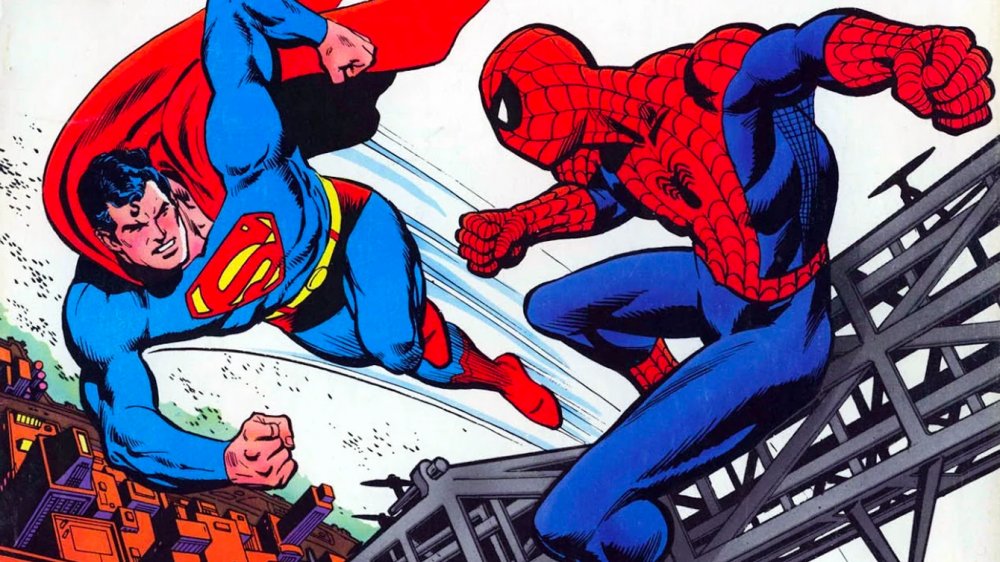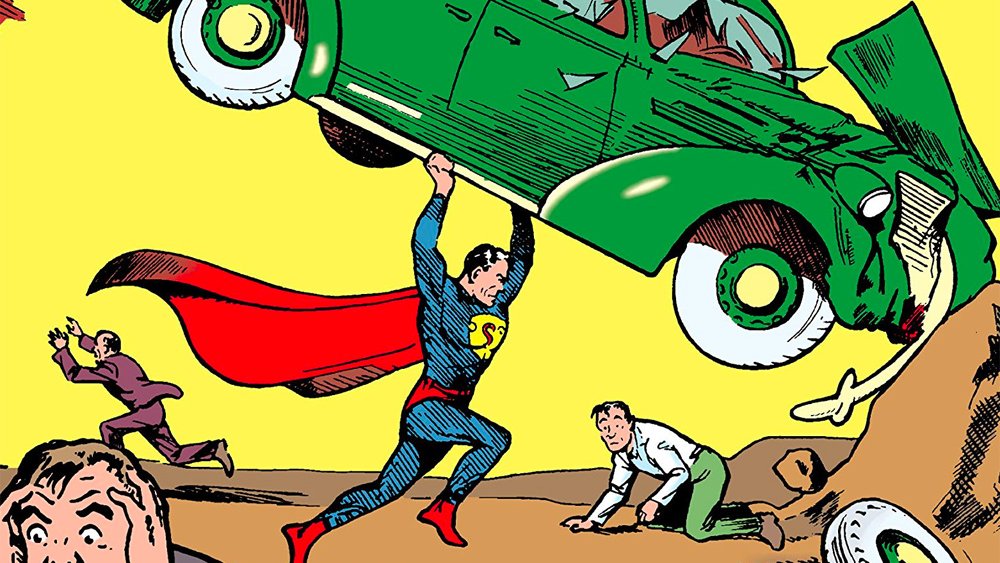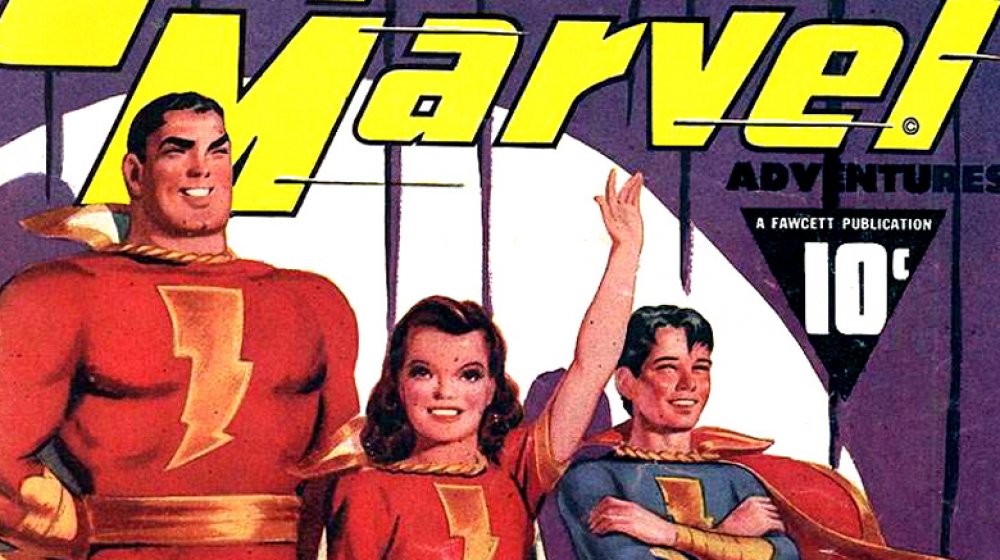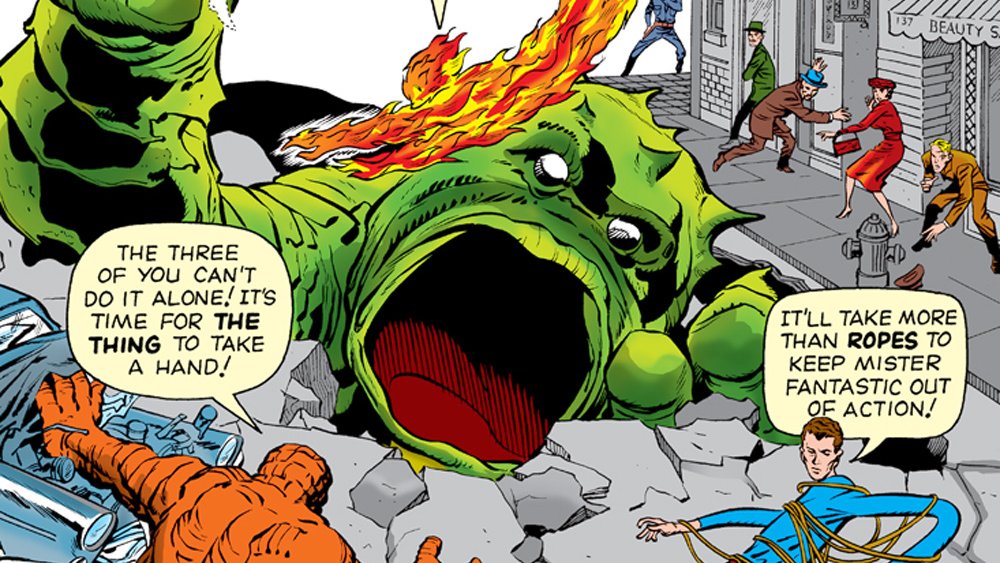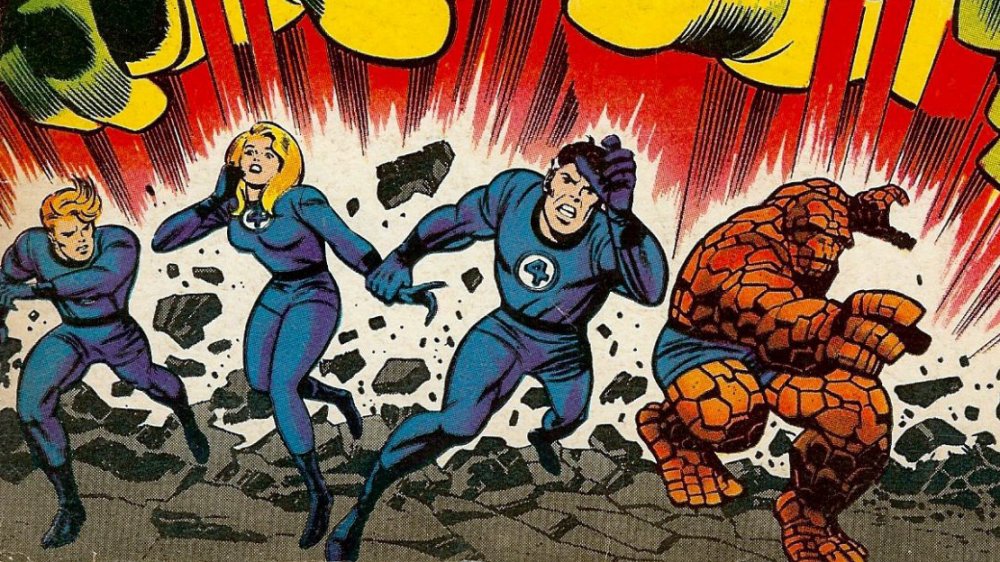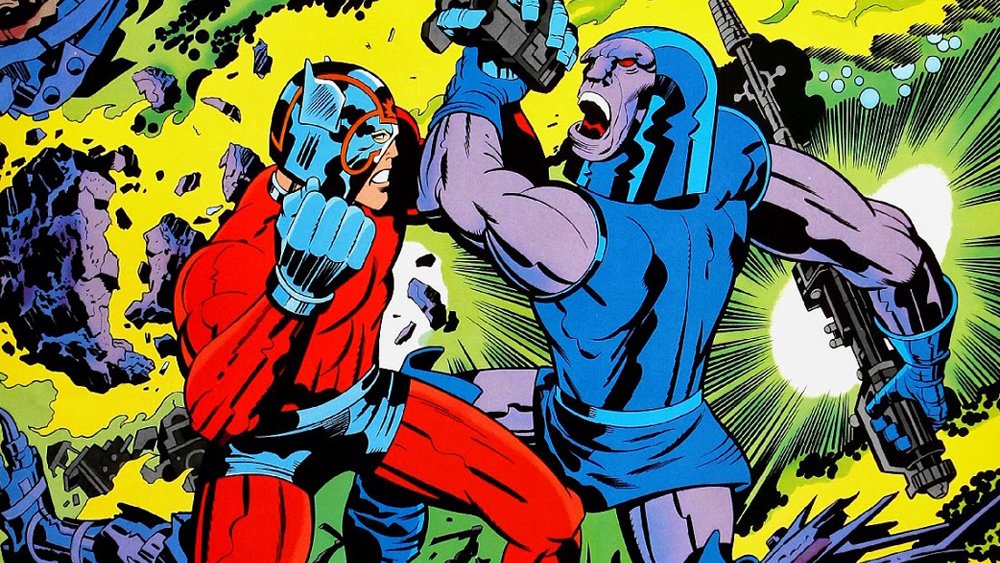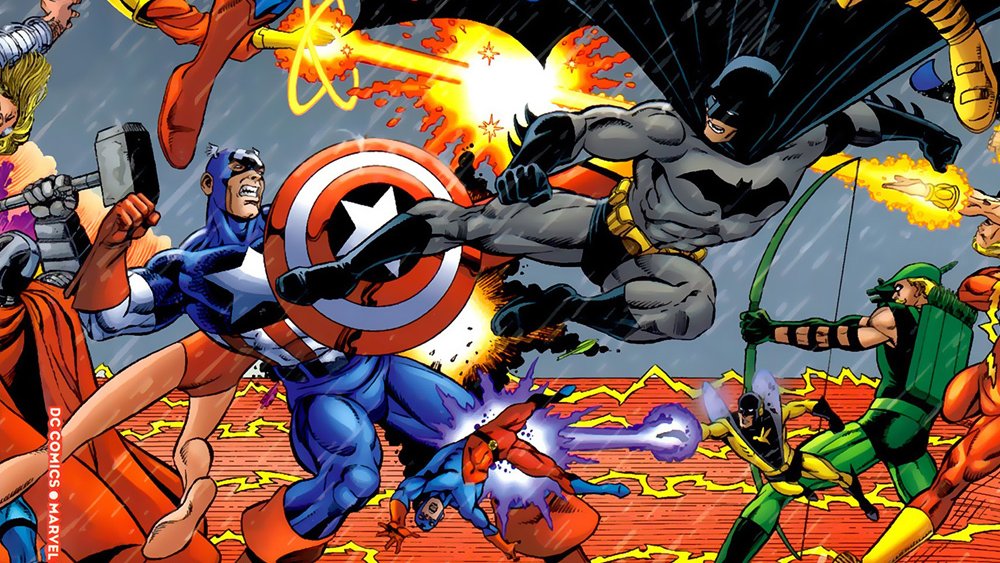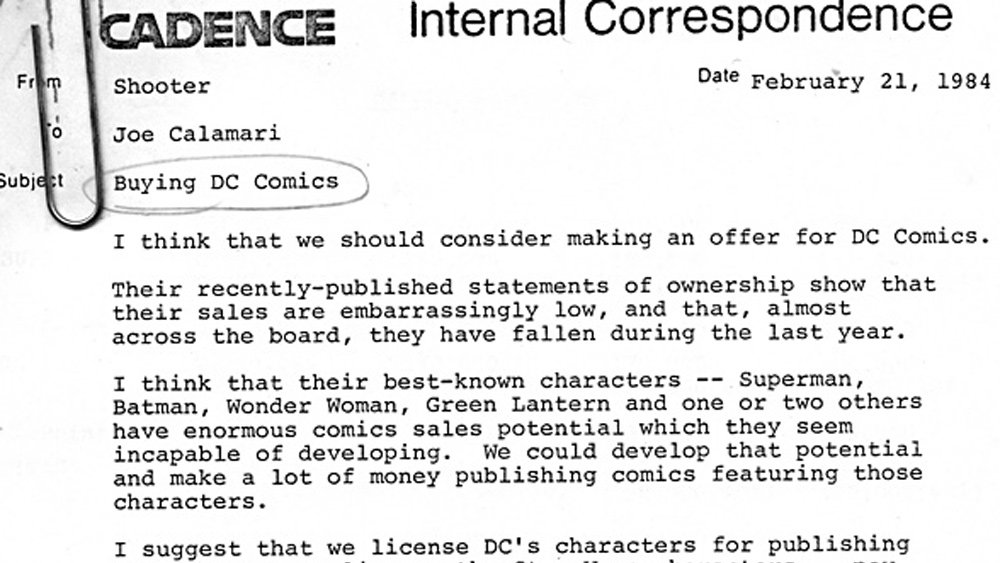The Untold Truth Of The Marvel Vs. DC Rivalry
In the long history of pop culture, there are very few rivalries that have sparked debates as intense as the one that rages between Marvel and DC — especially when you consider that both sides of this particular conflict were shaped by a lot of the same people. Since 1961, it's raged on letters pages, online arguments, and even within the comics themselves, and in the era when superhero movies are the biggest thing in Hollywood, it hasn't stopped.
But how did we get to this point? Was it just a good-natured competition that was taken to the extreme? The corporate world's most successful attempt to inspire brand loyalty for what basically amounts to a product? The natural endpoint of wondering if Thor could beat Superman in a fight? As it often is, the truth is a little more complicated, and winds its way through everything from irate editors to softball games. Here's the truth behind the rivalry between Marvel and DC.
Definitive Concepts
Technically, comic books had existed long before Superman burst onto the page in 1938, and even the idea of telling long-form adventure stories with panels and word balloons wasn't exactly new. If you've never gone back and read the Mickey Mouse newspaper strip from the late 1920s, for instance, you'd probably be surprised at how much they feel like the kind of adventures you'd be seeing in superhero comics 20 or even 30 years later (no, really, Mickey Mouse). When Jerry Siegel and Joe Shuster finally got someone to take a chance on the pitch they'd been shopping around for a few years about a baby from the planet Krypton who grew up to be Earth's greatest hero, though, they changed pretty much everything about the medium and ushered in a revolutionary new genre.
This new "superhero" concept took bits and pieces from sci-fi stories, pulp novel vigilantes, and those lavishly drawn adventure strips that were running in newspapers and combined them, and that idea worked. Superman himself was a massive hit, and by 1940, less than two years later, the newsstands were flooded with hundreds of new characters, most of which you've probably never heard of: The Green Turtle, Stardust the Super-Wizard, the Blonde Phantom, the Boy King and his Giant, Nightmare and Sleepy — those are some of the most well-known characters from that original boom that didn't survive.
There were a few that did, however, and those are the ones you definitely know, with Batman and Wonder Woman being at the head of the pack. The Flash, Green Lantern, Captain America and the Human Torch were in there, too, but even they couldn't make it through the entire time. Every one of those characters found their titles come to an end by the end of the '50s, if only for a few years.
Dubious Co-opting
The Golden Age also prompted something that would become something of a tradition in superhero comics: taking the most popular thing in the medium, ripping it off, and putting your own spin on it. Bill Finger and Bob Kane did it with the Shadow, debuting a blatant knockoff called Batman in the pages of Detective Comics, and there were countless burgeoning creators who did their best to file off the serial numbers and make the next Superman.
The most successful of these by far was, of course, Captain Marvel, the character who would eventually become known as Shazam. He was such a blatant knockoff, in fact — to the point where he's even throwing a car around on the cover of his first appearance, just like Superman — that he was eventually ruled to be infringing on the copyright, which led to DC eventually acquiring the character 40 years later. He was also wildly popular in comics, with Captain Marvel Adventures, which ran every two weeks, outselling the monthly Superman books.
But even though he lagged behind Shazam in comics sales, Superman had immediately crystallized as a pop cultural icon, partly because each was one of the first to branch out from the page and into another popular medium. In his case, it was a radio show so popular that they had to invent a plot device that could take Superman out of action — Kryptonite — so that voice actor Buds Collyer could take a break. That popularity gave Superman and his publishers a durability that allowed them to weather the oncoming storm. When superheroes lost their popularity after World War II and comics publishing experienced its first collapse, Superman was one of the few to stick around uninterrupted.
That enduring popularity, along with the fact that everyone else was floundering, also gave that publisher the chance to acquire or merge with many of their former competitors, one of which would give them a new name. While the company would formally be known as National Periodical Publications into the '70s, they'd eventually rebrand around their other flagship character as "Detective Comics" — DC for short.
Distinguished Competition
Since they'd cornered the market on the most popular characters in the genre — and since they'd been one of the primary forces behind the restrictive censorship of the Comics Code Authority, which kicked the legs out from under the popular crime and horror publishers who had filled the void after the superhero crash — DC cruised on through the '50s with virtually no competition. Their flagship character had even leaped over the transition from radio to television in a single bound.
And then Stan Lee and Jack Kirby came along and completely reinvented superheroes.
Weirdly enough, it all happened because of DC. After the Golden Age, the company that had originally published Captain America Comics limped along under a couple different names (Timely, then Atlas). They'd tried to revive their most popular character in the '50s as Captain America: Commie Smasher, but wound up with an extremely short run of comics so ill-advised and jingoistic that they were later retconned to be the adventures of a fake Cap whose bootleg super soldier serum had driven him insane. After that, they settled into pretty formulaic (but generally well-drawn) romance, war, and monster comics about space invaders with names like Shagg, Spragg, and one oddball called the Hulk (not that one, we'll get to him in a second).
In 1960, however, DC struck gold by putting all of their popular superheroes, and Aquaman, into a single book as the "Justice League of America." The publisher of Atlas, Martin Goodman, employed that time-honored strategy of ripping off a popular idea. He assigned Stan Lee, who he'd hired back in the '40s solely because he was he was his wife's cousin with aspirations of being a writer who had plenty of ideas and energy, and Jack Kirby, the veteran artist who had co-created Captain America in the '40s, to come up with a superhero team book of their own.
The thing is, Lee and Kirby approached things a little differently. Rather than just having a handful of super-powered good guys trounce an alien threat, they structured their "superheroes" like one of their sci-fi horror comics. A group of scientists, desperate to beat those dastardly commies to the moon, were exposed to radiation that gave them strange mutations, including turning one of them into a full-on monster. Then they fought off the bad guys. The only difference between this story and one of the lurid tales about Gruto and Korilla is that the people who would've been the tragic figures in a sci-fi comic triumphed and came back the next month to do it all again. The company would later rename itself after Timely's first comic from 1940, Marvel Comics, and that comic, Fantastic Four, wound up being so successful that an entire universe would be built on its foundation, and another one would be rebuilt.
Dismissive Comparisons
In the wake of Fantastic Four, Lee, Kirby, Steve Ditko, Marie Severin, Don Heck, and the other members of the original Marvel bullpen launched more series, and virtually all of them were a hit. The exception was the Hulk, which was canceled after only six issues, but he took off when he got a second shot after appearing in the first issues of The Avengers. It's easy to see why they were so successful, too. The ongoing dramas and soap operatic plots that influenced the Marvel books found a foothold with older readers — notably older teens and the college crowd — while the competition was still targeting a younger audience. Plus, the Marvel books were really good, with Lee's over-the-top dialogue soaring along with Kirby and Ditko's increasingly stylized art.
That's not to say that the DC comics of the early '60s weren't good. They're actually great. One of the many benefits that DC got from absorbing so many of their competitors in the '40s and '50s was that they got Otto Binder, the writer who had made Captain Marvel Adventures such a huge success, and made him one of the primary architects of the Superman titles. The '50s era of sci-fi Batman stories isn't remembered all that fondly, but Binder's work on Superman was full of concepts that are still in use today, from Brainiac to the Phantom Zone to Supergirl. Throw in the Silver Age reboots of characters like the Flash and Green Lantern, and DC was putting out the best comics they'd ever published. They're just a very different kind of good from what Marvel was doing, and when you saw the two companies' mags next to each other on the newsstand, the DC books looked basically the same as they had for ten years. The Marvel books, on the other hand, looked new and exciting, with blurbs that promised senses shattering drama and heroes in the kind of peril that Superman could never possibly face.
Stan Lee, who positioned himself as the friendly face of Marvel Comics — which, not coincidentally, involved actually crediting the writer, artist, and letterer in every issue, something DC wouldn't get around to for another decade — seized on this. In the letters columns that ran in Fantastic Four, he'd trash "the Distinguished Competition" as being "Brand Ecch," and insisted that Marvel's comics were the ones that respected the readers' intelligence, unlike those other guys. DC, for what it's worth, rarely if ever mentioned Marvel in their letter columns, but the fact that said columns were mostly devoted to editors arguing with children didn't help. Lee's brand-building diatribes eventually got so bad that readers who enjoyed both publishers wrote in asking him to stop insulting their taste. Lee responded by running a poll to see if the readers wanted him to keep talking about how bad DC was, or if he should just stick to talking about how much better his own comics were. With that, the battle lines were drawn.
Departing Creators
Over the next ten years, Marvel produced some of the best superhero comics ever published, including the Galactus story from Fantastic Four that's basically the blueprint for every "event" comic since, and "The Final Chapter" from Amazing Spider-Man #33, which featured imagery that defined the character so well that it was used in Spider-Man: Homecoming 50 years later. They'd also broken into TV with cartoons, which mostly had bad animation, but great theme songs. Clearly, they weren't going anywhere anytime soon.
With that in mind, DC made one of the boldest moves in years: they hired Jack Kirby in 1971. It was no secret that Kirby had done the lion's share of work on Fantastic Four. One of the reasons that he was able to write so many comics while also editing the whole line is that he and the artist would hash out a plot, usually a couple of sentences then the artist would draw the entire issue, often writing in dialogue in the margins, and Lee would then script the dialogue for the finished pages. Kirby, however, felt that Lee had taken the lion's share of the credit, and he wasn't alone. Spider-Man co-creator Steve Ditko left Marvel a few years earlier, partly due to a similar personal conflict with Lee that saw their last year of Amazing Spider-Man stories produced without the two of them speaking to each other.
DC offered Kirby a massive amount of freedom and creative control that essentially meant he could do whatever he wanted, which is what he did. After a few months of ads announcing that "The Great One Is Coming," Kirby's run at DC debuted in Superman's Pal Jimmy Olsen, and then moved onto the epic "Fourth World" saga that ran through New Gods, Mister Miracle, and Forever People as well. He was writing and drawing a complete, often groundbreaking comic every two weeks, introducing a grand mythology that was built around a conflict with Darkseid, an alien god who embodied evil. He worked out a lot of his frustrations there, too, particularly through a pretty vicious parody of Stan Lee named Funky Flashman who showed up in Mister Miracle. During his time at DC, he also produced the bizarre, dystopian, and weirdly prescient OMAC (starring the One Man Army Corps) and the supernatural adventures of The Demon.
Considering he'd just come off 108 issues of Fantastic Four, Kirby's work at DC was surprisingly short-lived, although it remains hugely influential. By 1976, though, he was back at Marvel with the same level of creative control, doing his third run of Captain America and creating The Eternals, another mythical saga of space gods. He also did Devil Dinosaur, which is nine issues about a giant red Tyrannosaurus kicking the living hell out of other dinosaurs and occasionally aliens, which rules. By the '80s, he was mostly working in the more stable field of animation, but went back to DC for Super Power and The Hunger Dogs. Either way, Kirby's tenure at DC proved that even the most Marvel Comics creator there was could cross the street, and that DC was willing to try their own hand at replicating the success of others.
Dueling Corporations
Throughout the '70s and '80s, the first generation of creators who had grown up with the Marvel Universe became the people behind the comics, swapping creators back and forth and attempting to keep up with each other. As the people in the offices were all located in New York (DC relocated to Los Angeles in 2015), most of them were even friends — there's a truly weird unofficial crossover from 1972 in which a group of creators were on a road trip that took them through DC's Justice League of America and Marvel's Amazing Adventures and Thor. Staffers at the two companies would also square off for softball games in Central Park, although former Marvel Editor-in-Chief Jim Shooter alleged that DC would bring in ringers to win.
As for the comics, the creators would switch back and forth between the two companies, often breaking in at one and then doing major work at the other. When X-Men was the most popular Marvel book in the '80s, for instance, DC hired two creators who had started at Marvel, George Pérez and Marv Wolfman, to do their own similar superhero soap opera with New Teen Titans. In the late '80s, when Todd McFarlane and Rob Liefeld were bringing a whole new style to DC in Invasion and Hawk & Dove, DC hired them to take Spider-Man and New Mutants in new directions. After Marvel had success with Secret Wars, a 12-part crossover featuring all of their most popular characters, DC did Crisis on Infinite Earths, a 12-part crossover featuring all of their characters that ended up eliminating their Silver Age multiverse and rebooting the universe to be more like Marvel's.
By the end of the '80s, there was a corporate element to it, too. In effect, DC's purchase by Warner Bros. was started in 1967, and by the time the dust settled, the studio had designs on turning DC's roster of popular characters into movie stars — something they did with great success when Superman: The Movie was released in 1978. Marvel, meanwhile, had been through a series of parent companies, including a period when they were a division of the Perfect Film and Chemical Corporation, before incorporating as Marvel Entertainment Group in 1986. In 2009, though, Marvel — after bouncing back from bankruptcy in the late '90s and finally getting on the big screen in a way that could challenge Warner's superhero film franchises — was bought by Disney, bringing the two companies into the same strata of corporate ownership, and ensuring that their years of rivalry will continue indefinitely, while pretty much everyone in the world watches.
Dream Crossover
Long before Disney took over, though, the corporate aspect of comics publishing led to one of the strangest moments in the history of their long rivalry. As Shooter recounts, there was a moment in 1984 when Marvel came very close to taking over the entire DC Universe — literally.
The short version was that someone at Warners realized that while the characters were a gold mine for action figures and other licensed products, DC was losing money publishing comics, and figured they'd be better off letting someone else publish them. The obvious choice? Marvel. They've got experience publishing comics, right? Shooter was approached with an offer of the publishing license for DC's characters, meaning that Superman and Batman would join G.I. Joe and Star Wars on the roster of Marvel's licensed comics, and give Marvel complete dominance of the superhero genre.
If it had happened a few years earlier or later, the comics industry could be very different today, and it got as far as Shooter making a full pitch for how they'd pull it off. Alas, a smaller publisher sued Marvel around that time, alleging that they were an illegal monopoly because they already controlled so much of the comics market. "When you're being sued under anti-trust laws," wrote Shooter in 2011, "it's a bad time to devour your largest competitor."
